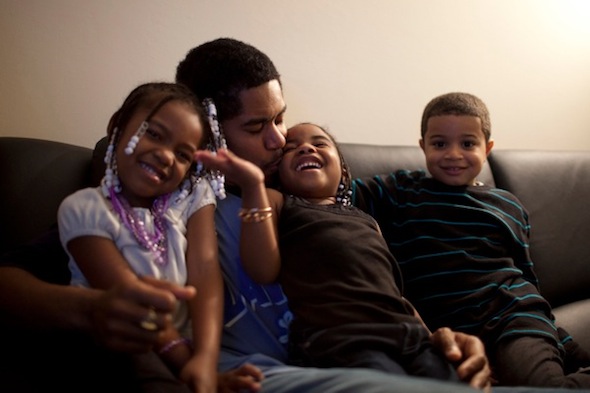
Photo Credit: Matt Richter
Two men lift a waterlogged piece of furniture up and out of a flooded living room. A woman walks down from her Manhattan apartment to the street below to spontaneously direct traffic because the lights aren’t working. A group of kids peer over the edge of a church balcony onto the organized chaos of a donation hub below.
These, and dozens more simple yet vivid scenes of life after Hurricane Sandy, which battered New York City last October, are captured on the Sandy Storyline website–a “participatory documentary” project that is as compelling as it is admirable. The project went online about a month after the storm and since then has served as a repository for photos, audio clips, and short pieces of text, all focused on the people most affected in New York and New Jersey. As of this weekend, some of these collected stories are also on display in an interactive installation at the Tribeca Film Festival in Manhattan.
Ariel Newland Kennan, a Code for America fellow and one of Sandy Storyline’s designers, says she met the other soon-to-be founders of the project when they were all volunteering together in the aftermath of the storm. The others already had the “nugget” of the idea, she says, and they put it together quickly and seamlessly, with the help of open-source software.
Kennan says that two of the original cofounders, Michael Premo and Rachel Falcone, had previously worked at StoryCorps (a third, Laura Gottesdiener, is a journalist). Indeed, the project rings true to the StoryCorps ethos. Record what you can now, and help make history. Get people talking, and help them heal.
“There was such an outpouring of wanting to help in any way after the storm,” said Kennan, “and I think a lot of us felt like, we can go do this volunteer stuff, but what’s the longer impact that we can have with our professional skills?”
One of Sandy Storyline’s strengths is that, in having that common impulse to collect people’s stories, they didn’t wait passively to receive them. Anyone can send in a text, or write an email, or call in to record a voicemail with his or her story–but Sandy Storyline can come to them, too. A growing network of journalists are going out to affected areas to look for material for the site or to visit people upon request to help capture their stories.
The key to Sandy Storyline’s method, Kennan says, was offering people as many ways of participating as possible–for obvious reasons. “We really wanted to make the content accessible, to not just make it something that people with Internet connections can get to,” she says. “Especially right after the storm, when a lot of people had no power.”
The result is a pastiche of voices and images–many professional, others amateur–all presented on the site with equal weight and authority. The site is clean and organized, and yet, the effect of all the tiled images one after the other is appropriately raw and enveloping. As a place to start exploring, some especially strong moments include “PTSD: Post Traumatic Sandy Disorder,” and “My Mind is So Hooked On Cleaning.”
The current iteration of Sandy Storyline is the third one, Kennan says, but she and her colleagues will soon launch a fourth. They’ve been using the visually striking, open-source storytelling platform Cowbird. But it does not allow for video–hence the forthcoming redesign.
As much as it has grown online in the past four months, Sandy Storyline has quickly expanded to the offline world, as well. The site’s growing network of volunteer journalists includes workshops in Hoboken and Staten Island local kids are trained to use recording equipment and go out collecting stories from their neighbors–a method that StoryCorps has also used in the past. “We have them now recording in their communities, and they get such a richer story, since they are actually part of that community,” says Kennan.
Kennan says Sandy Storyline hopes to collect even more tweets, texts, photos, and voices at the Tribeca Film Festival this weekend. This is the first year of Tribeca’s “Storyscapes” program, which includes Sandy Storyline and several other documentary projects. The installation is made up of several screens, displaying visitor-contributed tweets in real time, benches to sit and watch an hourlong video collage, and, fittingly, a mobile phone charging station.
The Sandy Storyline exhibit on Varick Street opened Thursday evening and runs until Sunday night. (It is open and free to the public: more information here.) After that, says Kennan, the display may be broken up into parts and set up in various affected communities, where the story collecting will continue.
As quickly as this project has grown, and as directly inspired as it was by this particular disaster, the founders say they can also see real potential for the platform’s extended life. “We want to keep it open-source, and we want to keep the process transparent, so that when another event happens, that this entire platform could be turned on again, or replicated,” says Kennan.
To that end, they are applying for grants and soliciting reader donations, to help build and support the technology needed to help the project continue. Kennan added that it made no difference to them whether the platform is used by the same network of journalists the next time around, or by anyone else. What matters is that Storyline can be of use to the people who have the stories to tell, at just the time when they may need to tell them most.
Lauren Kirchner is a freelance writer covering digital security for CJR. Find her on Twitter at @lkirchner
